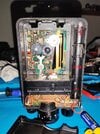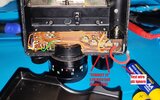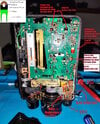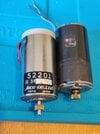SpookySnek
- Jun 13, 2024
- 4
- Joined
- Jun 13, 2024
- Messages
- 4
Hello guys!
I am currently trying to repair this old Super-8 camera (Agfa Microflex 300).
After cleaning and fixing a connection that was broken due to battery leakage, the camera now seems to work as it should, with one caveat: I need to push the gears forward "ever so slightly" to make it actually start moving. I've lubricated the gears and shafts to no avail. I've cleaned the contact points that switch on the motor. I've tried adjusting the variable resistors one by one, not really knowing what most of them does.
The motor is a 3V DC motor and receives around 2.8V. I've tried to find info on the "NEC MC-5059" IC to no avail. I've also tried to find a service manual or something of that nature with explanations for the PCB and components, but it doesn't seem to exist anywhere on the internet.
I think that my next step will be to replace all the capacitors with new ones in hopes that at least one of them is used to "kick start" the motor, although my electronics knowledge is way too slim for me to see which one of the caps that could be used for this, if any. Could it help? Hopefully my conversion of the color codes is correct, it does seem to be very low values though.
I also plan on replacing the old "STABILYT 12" 1.5v battery cell with diodes + a cap (found a solution in an obscure german vintage radio forum), I do believe this is only used for the light sensor though.
The second motor (the one next to the lens, "outside" of the camera body) is used for zooming and works fine.
Any help at all that could lead me in the right direction would be greatly appreciated!! <3
I am currently trying to repair this old Super-8 camera (Agfa Microflex 300).
After cleaning and fixing a connection that was broken due to battery leakage, the camera now seems to work as it should, with one caveat: I need to push the gears forward "ever so slightly" to make it actually start moving. I've lubricated the gears and shafts to no avail. I've cleaned the contact points that switch on the motor. I've tried adjusting the variable resistors one by one, not really knowing what most of them does.
The motor is a 3V DC motor and receives around 2.8V. I've tried to find info on the "NEC MC-5059" IC to no avail. I've also tried to find a service manual or something of that nature with explanations for the PCB and components, but it doesn't seem to exist anywhere on the internet.
I think that my next step will be to replace all the capacitors with new ones in hopes that at least one of them is used to "kick start" the motor, although my electronics knowledge is way too slim for me to see which one of the caps that could be used for this, if any. Could it help? Hopefully my conversion of the color codes is correct, it does seem to be very low values though.
I also plan on replacing the old "STABILYT 12" 1.5v battery cell with diodes + a cap (found a solution in an obscure german vintage radio forum), I do believe this is only used for the light sensor though.
The second motor (the one next to the lens, "outside" of the camera body) is used for zooming and works fine.
Any help at all that could lead me in the right direction would be greatly appreciated!! <3
Attachments
Last edited:





